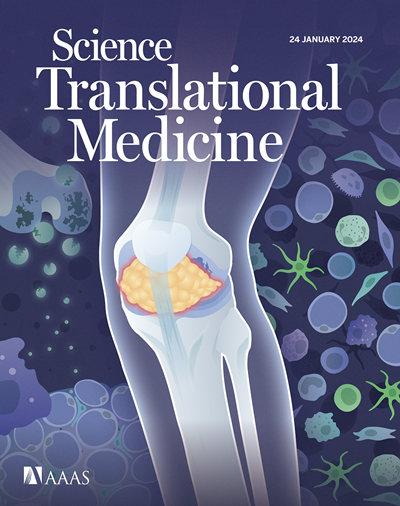Semisynthetic guanidino lipoglycopeptides with potent in vitro and in vivo antibacterial activity
IF 14.6
1区 医学
Q1 CELL BIOLOGY
引用次数: 0
Abstract
Gram-positive bacterial infections present a major clinical challenge, with methicillin- and vancomycin-resistant strains continuing to be a cause for concern. In recent years, semisynthetic vancomycin derivatives have been developed to overcome this problem as exemplified by the clinically used telavancin, which exhibits increased antibacterial potency but has also raised toxicity concerns. Thus, glycopeptide antibiotics with enhanced antibacterial activities and improved safety profiles are still necessary. We describe the development of a class of highly potent semisynthetic glycopeptide antibiotics, the guanidino lipoglycopeptides, which contain a positively charged guanidino moiety bearing a variable lipid group. These glycopeptides exhibited enhanced in vitro activity against a panel of Gram-positive bacteria including clinically relevant methicillin-resistant Staphylococcus aureus (MRSA) and vancomycin-resistant strains, showed minimal toxicity toward eukaryotic cells, and had a low propensity for resistance selection. Mechanistically, guanidino lipoglycopeptides engaged with bacterial cell wall precursor lipid II with a higher binding affinity than vancomycin. Binding to both wild-type d-Ala-d-Ala lipid II and the vancomycin-resistant d-Ala-d-Lac variant was confirmed, providing insight into the enhanced activity of guanidino lipoglycopeptides against vancomycin-resistant isolates. The in vivo efficacy of guanidino lipoglycopeptide EVG7 was evaluated in a S. aureus murine thigh infection model and a 7-day sepsis survival study, both of which demonstrated superiority to vancomycin. Moreover, the minimal to mild kidney effects at supratherapeutic doses of EVG7 indicate an improved therapeutic safety profile compared with vancomycin. These findings position guanidino lipoglycopeptides as candidates for further development as antibacterial agents for the treatment of clinically relevant multidrug-resistant Gram-positive infections.
具有强效体外和体内抗菌活性的半合成胍基脂甘肽。
革兰氏阳性细菌感染是一项重大的临床挑战,耐甲氧西林和耐万古霉素菌株一直是令人担忧的问题。近年来,人们开发了半合成万古霉素衍生物来解决这一问题,临床上使用的泰拉万星就是一例,它具有更强的抗菌效力,但也引发了毒性问题。因此,仍然需要抗菌活性更强、安全性更好的糖肽类抗生素。我们介绍了一类高效半合成糖肽抗生素--胍基脂甘肽的开发情况,这种抗生素含有一个带正电荷的胍基,并带有一个可变的脂基。这些糖肽对一系列革兰氏阳性细菌(包括临床相关的耐甲氧西林金黄色葡萄球菌(MRSA)和耐万古霉素菌株)具有更强的体外活性,对真核细胞的毒性极小,而且耐药性选择倾向低。从机理上讲,胍基脂甘肽与细菌细胞壁前体脂质 II 的结合亲和力高于万古霉素。与野生型 d-Ala-d-Ala 脂质 II 和对万古霉素耐药的 d-Ala-d-Lac 变体的结合均得到了证实,这为胍基聚糖肽增强对万古霉素耐药分离菌的活性提供了启示。在金黄色葡萄球菌小鼠大腿感染模型和 7 天败血症存活研究中评估了胍基脂多糖肽 EVG7 的体内疗效,结果均显示其优于万古霉素。此外,与万古霉素相比,EVG7 在超治疗剂量时对肾脏的影响极小至轻微,这表明其治疗安全性有所提高。这些研究结果表明,胍基脂甘肽可作为抗菌剂进一步开发,用于治疗临床相关的耐多药革兰氏阳性感染。
本文章由计算机程序翻译,如有差异,请以英文原文为准。
求助全文
约1分钟内获得全文
求助全文
来源期刊

Science Translational Medicine
CELL BIOLOGY-MEDICINE, RESEARCH & EXPERIMENTAL
CiteScore
26.70
自引率
1.20%
发文量
309
审稿时长
1.7 months
期刊介绍:
Science Translational Medicine is an online journal that focuses on publishing research at the intersection of science, engineering, and medicine. The goal of the journal is to promote human health by providing a platform for researchers from various disciplines to communicate their latest advancements in biomedical, translational, and clinical research.
The journal aims to address the slow translation of scientific knowledge into effective treatments and health measures. It publishes articles that fill the knowledge gaps between preclinical research and medical applications, with a focus on accelerating the translation of knowledge into new ways of preventing, diagnosing, and treating human diseases.
The scope of Science Translational Medicine includes various areas such as cardiovascular disease, immunology/vaccines, metabolism/diabetes/obesity, neuroscience/neurology/psychiatry, cancer, infectious diseases, policy, behavior, bioengineering, chemical genomics/drug discovery, imaging, applied physical sciences, medical nanotechnology, drug delivery, biomarkers, gene therapy/regenerative medicine, toxicology and pharmacokinetics, data mining, cell culture, animal and human studies, medical informatics, and other interdisciplinary approaches to medicine.
The target audience of the journal includes researchers and management in academia, government, and the biotechnology and pharmaceutical industries. It is also relevant to physician scientists, regulators, policy makers, investors, business developers, and funding agencies.
 求助内容:
求助内容: 应助结果提醒方式:
应助结果提醒方式:


